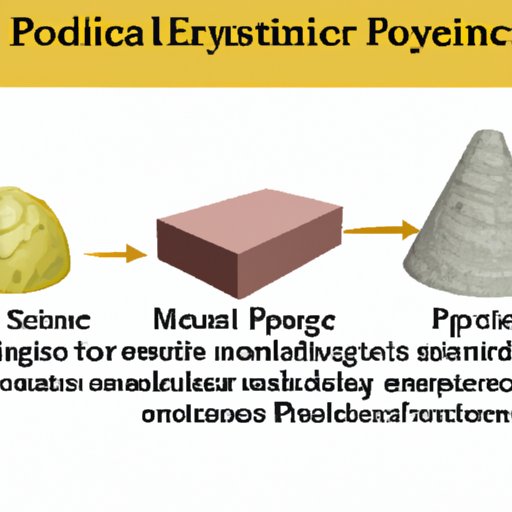
Introduction
Physical properties are all around us, from the materials we use in our everyday lives to the scientific tools we use in research and experimentation. Understanding physical properties is essential not only for scientists but also for students, engineers, and anyone who wants to understand the world around them. In this article, we will explore what physical properties are, how they impact our world, and their significance in the scientific community.
The Basics of Physical Properties: Defining and Explaining Them
Physical properties are the characteristics that can be measured or observed without altering the identity of a substance. These properties include but are not limited to color, mass, volume, density, conductivity, viscosity, and melting and boiling points. In science, physical properties are extensively used to describe, classify, and identify materials.
The study of physical properties is fundamental in various scientific disciplines, including chemistry, physics, and materials science. They play an essential role in the development of new materials, in the understanding of biological systems and environmental processes, and in the improvement of industrial processes.
Examples of physical properties are abundant in our daily lives. For instance, we can identify metals by their conductance of electricity; we can differentiate liquids based on their viscosity, and we can classify plastics by their melting point and density. Physical properties are incredibly relevant and important in our everyday experiences.
5 Common Examples of Physical Properties and How They Impact Our World
Here are five examples of physical properties that are commonly encountered in our day-to-day lives:
Density
Density is the amount of matter present in a material per unit volume. It is crucial in industries such as food, construction, and manufacturing. For example, in the food industry, companies measure the densities of different food products to ensure they get the correct amount of ingredients for each batch they produce. The density of materials also determines their properties and how they are used in construction. For instance, high-density concrete is used in bridges and buildings that require high strength and durability.
Conductivity
Conductivity is the ability of a material to conduct electricity and heat. This property is relevant in electronic devices such as circuits, and in the household appliances we use. For example, metals are good conductors of electricity and are used in wiring, while ceramics are commonly used in electric insulators because they do not conduct electricity.
Viscosity
Viscosity is the resistance of a fluid to flow. It is essential in various fields, like the oil and gas industry, where different fluids have different viscosities that determine how they flow through pipelines. The viscosity of motor oil is crucial for the smooth functioning of car engines, as thicker oil will cause more resistance and heat to generate within the engine.
Color
Color is a physical property that is commonly used for artistic and aesthetic purposes, as well as for identification and classification in chemistry and biology. For example, food color is commonly used in the food industry to make products more attractive to consumers, while colored indicators are used in chemical experiments to show when a reaction has occurred.
Melting and Boiling Points
Melting and boiling points are the temperatures at which a substance changes state from a solid to liquid and from a liquid to gas, respectively. These properties are crucial in determining how different materials interact with each other in various industries, such as in metallurgy and chemical engineering. For example, the melting point of a metal is used to determine its strength and durability, while high boiling point liquids are used for industrial processes like distillation.
Exploring the Differences Between Physical and Chemical Properties
Physical and chemical properties are often categorized separately because they refer to differentiating characteristics of substances.
Physical properties are those that can be observed without changing the substance’s chemical identity. Examples include color, texture, density, and boiling point. On the other hand, chemical properties refer to the characteristic reactions of substances with other materials, which may result in a change in identity. An example of chemical properties is the reaction of iron with oxygen to form rust. The rust has different chemical properties than the iron it originated from.

The Role of Physical Properties in Materials Science and Engineering
Physical properties play a key role in materials science and engineering. Scientists and engineers use these properties to design materials with specific applications and properties. For example, they use the properties of metals to design alloys that are stronger and more corrosion-resistant than pure metals. In nanotechnology, properties such as surface area and reactivity become critical factors to engineering materials with unique sizing and functionality.
Physical Properties of Matter: An Overview for Students
Physical properties are crucial to understand for students of all levels, from elementary school to college. They are essential for describing and identifying different materials and for understanding how they interact with each other. Examples of physical properties that students encounter daily include color, texture, shape, and flexibility. Through hands-on, interactive learning, students can get a grasp of how physical properties work, related to real-life materials they encounter every day.
The Importance of Understanding Physical Properties in the Lab
Physical properties are essential in laboratory settings because they allow researchers to obtain accurate and reliable measurements. Scientists must consider physical properties when conducting experiments, as they play a crucial role in the effectiveness and accuracy of the experiment. For example, viscosity determines the size of droplets produced during a spray deposition process, which affects the size of nanoparticles produced, making physical property analysis fundamental.
Using Physical Properties to Identify Unknown Substances
Physical properties can also be used to identify unknown substances. By analyzing the physical properties of a substance, scientists and engineers can differentiate and classify the material. For example, the boiling point, melting point, and density of an unknown substance can all be compared with known values to determine its identity. By understanding the physical properties of a material, researchers can get an idea of a material’s potential uses, as well as its underlying chemical and material properties.
Conclusion
In summary, physical properties are properties that describe a substance without changing its identity. Examples of physical properties include density, conductivity, viscosity, color, and melting and boiling points. These properties are relevant in various aspects of our lives, from industry and manufacturing to research and experimentation. Understanding physical properties can help to improve industrial processes, develop new materials, and improve the quality of life through technological advancements.




